FIGURE 5. Ghrelin/GHS-R interactions play an autocrine role in astrocytoma cell motility.

A and B, compared with control (C) siRNA, GHS-R siRNA caused a significant reduction of GHS-R mRNA and protein content in U-87 cells within 24 h. GAPDH, glyceraldehyde-3-phosphate dehydrogenase; DAPI, 4′,6-diamidino-2-phenylindole. C, ghrelin treatment of GHS-R siRNA-transfected cells failed to increase motility compared with control cells. In addition, note that GHS-RsiRNA cells displayed much reduced motility as observed by reduced closure of the scratch 24 h post-transfection. D, disruption of the ghrelin/GHS-R axis caused a significant reduction of MMP2 activity in U-87 and SW1088 cells, but not in U-118 cells. E, shown is the real-time PCR analysis of the amplification plots of U-87 cells transfected with empty vector (pcDNA3.1 (PCDNA)) and GHS-R. Rn, reaction. F, shown is the -fold change in GHS-R expression in U-87 cells stably transfected with GHS-R1a clone 10 (GHSR1a10)). G, U-87 cells overexpressing GHS-R1a exhibited increased motility compared with cells transfected with empty vector alone in a scratch assay.
